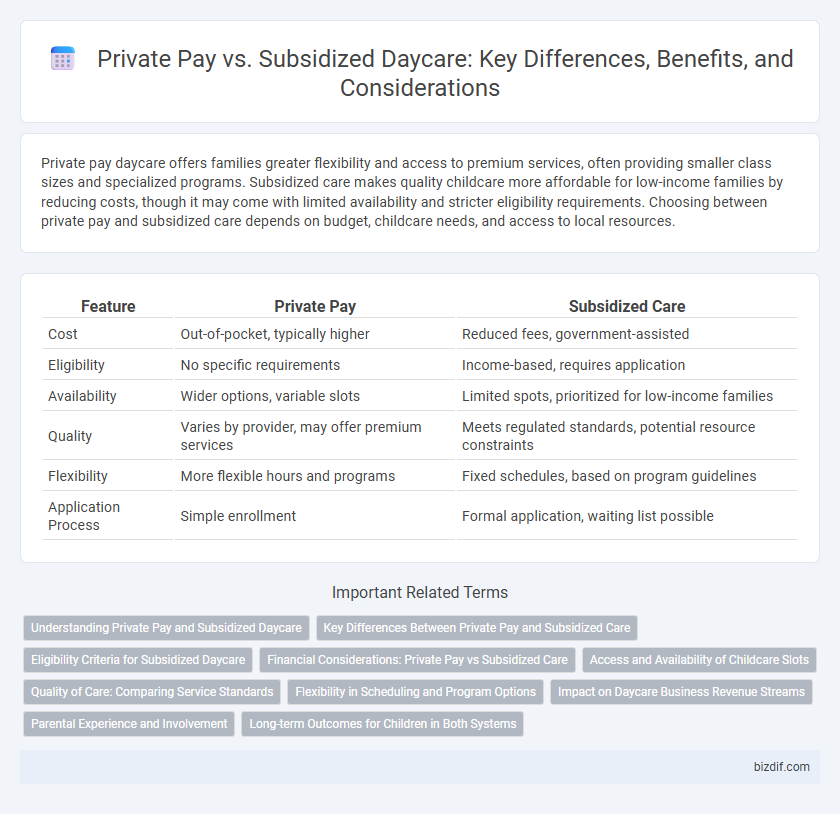Private pay daycare offers families greater flexibility and access to premium services, often providing smaller class sizes and specialized programs. Subsidized care makes quality childcare more affordable for low-income families by reducing costs, though it may come with limited availability and stricter eligibility requirements. Choosing between private pay and subsidized care depends on budget, childcare needs, and access to local resources.
Table of Comparison
| Feature | Private Pay | Subsidized Care |
|---|---|---|
| Cost | Out-of-pocket, typically higher | Reduced fees, government-assisted |
| Eligibility | No specific requirements | Income-based, requires application |
| Availability | Wider options, variable slots | Limited spots, prioritized for low-income families |
| Quality | Varies by provider, may offer premium services | Meets regulated standards, potential resource constraints |
| Flexibility | More flexible hours and programs | Fixed schedules, based on program guidelines |
| Application Process | Simple enrollment | Formal application, waiting list possible |
Understanding Private Pay and Subsidized Daycare
Private pay daycare requires parents to cover the full cost of care out of pocket, often allowing access to more flexible hours and specialized programs. Subsidized daycare is funded by government programs aimed at making childcare affordable for low- to moderate-income families, with eligibility based on income and family size. Understanding the distinctions helps parents choose the best option for their financial situation and childcare needs.
Key Differences Between Private Pay and Subsidized Care
Private pay daycare requires families to cover the full cost of childcare services, often providing greater flexibility in program choices and hours of care. Subsidized care is funded by government programs, reducing costs for eligible low-income families but usually limiting options to approved providers and specific enrollment criteria. Understanding these distinctions helps parents balance affordability, availability, and quality when selecting daycare options.
Eligibility Criteria for Subsidized Daycare
Subsidized daycare eligibility criteria often include income limits, family size, and employment or educational status of the parent or guardian. Low-income families typically qualify by meeting state or local government thresholds, which vary by region and funding availability. Documentation such as proof of income, residency, and employment or enrollment in education programs is usually required to access subsidized care.
Financial Considerations: Private Pay vs Subsidized Care
Private pay daycare typically offers more flexible scheduling and premium services but requires families to cover full tuition costs, which can range from $200 to $1,200 per week depending on location and care quality. Subsidized care programs, funded by government assistance like the Child Care and Development Fund (CCDF), reduce out-of-pocket expenses significantly, often capping family contributions based on income levels. Evaluating total financial impact involves comparing potential subsidies, eligibility criteria, and long-term affordability to determine the best childcare investment.
Access and Availability of Childcare Slots
Private pay daycare offers greater flexibility in access and typically more immediate availability of childcare slots due to fewer restrictions and higher fees. Subsidized care increases affordability for low-income families but often faces limited availability and longer waitlists due to funding caps and high demand. Balancing private pay and subsidized options is crucial for expanding overall childcare access and meeting diverse family needs.
Quality of Care: Comparing Service Standards
Private pay daycare often offers higher quality of care with smaller class sizes, more experienced staff, and enriched learning environments tailored to individual children's needs. Subsidized care, while more accessible financially, may have larger groups and limited resources due to budget constraints, potentially impacting personalized attention and educational offerings. Evaluating service standards reveals private pay centers typically maintain stricter accreditation and ongoing staff training, enhancing overall child development outcomes.
Flexibility in Scheduling and Program Options
Private pay daycare offers greater flexibility in scheduling and program options, allowing families to customize hours and activities based on their specific needs. Subsidized care often comes with fixed schedules and limited program choices due to funding and regulatory constraints. Families prioritizing adaptable care solutions typically find private pay settings more accommodating to diverse routines and preferences.
Impact on Daycare Business Revenue Streams
Private pay daycare services typically generate higher revenue per child due to full tuition fees without government caps, enhancing cash flow and profitability for operators. Subsidized care often relies on government funding with fixed reimbursement rates, which can limit revenue potential but increase enrollment stability through guaranteed subsidies. Balancing both payment models allows daycare businesses to diversify income streams, optimize capacity utilization, and mitigate financial risks associated with market fluctuations.
Parental Experience and Involvement
Private pay daycare often allows parents greater involvement in daily activities and decision-making, fostering a personalized caregiving experience. Subsidized care, while more affordable, may have larger class sizes and standardized routines that limit parental input in program customization. Families choosing private pay frequently report higher satisfaction due to increased communication and tailored educational approaches.
Long-term Outcomes for Children in Both Systems
Long-term outcomes for children in private pay daycare systems often reflect enhanced cognitive development and social skills due to lower child-to-staff ratios and more individualized attention. Subsidized care programs, while increasing access for low-income families, may face challenges like resource limitations and higher staff turnover, which can impact consistent learning experiences. Research highlights that quality of care, rather than payment source, is the critical factor influencing children's academic success and emotional well-being over time.
Private Pay vs Subsidized Care Infographic

 bizdif.com
bizdif.com